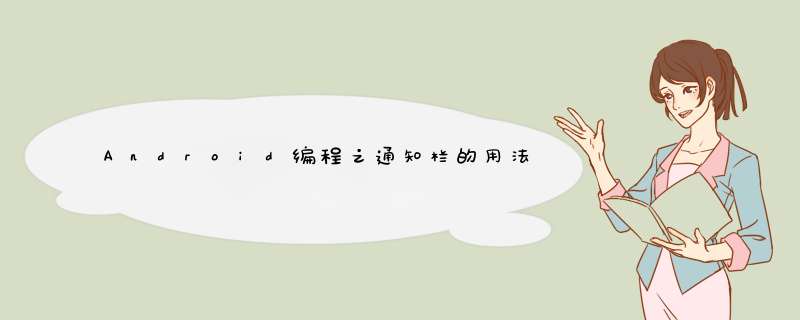
本文实例总结了AndroID编程中通知栏的用法。分享给大家供大家参考,具体如下:
很久没有使用AndroID的通知功能了,今天把两年前的代码搬出来一看,发现很多方法都废弃了,代码中各种删除线看的十分不爽。于是乎,打开Google,查看官方文档,学习最新的发送通知栏消息的方法。
本文中的代码均参照谷歌官方文档编写:
http://developer.androID.com/guIDe/topics/ui/notifIErs/notifications.HTML
1.首先,获取系统的通知服务:
复制代码 代码如下:notificationmanager nm = (notificationmanager) getSystemService(Context.NOTIFICATION_SERVICE);
2.发送一个最简单的通知
public voID simpleNotice(VIEw vIEw) { //此Builder为androID.support.v4.app.NotificationCompat.Builder中的,下同。 Builder mBuilder = new Builder(this); //系统收到通知时,通知栏上面显示的文字。 mBuilder.setTicker("天津,晴,2~15度,微风"); //显示在通知栏上的小图标 mBuilder.setSmallicon(R.drawable.consult_answer); //通知标题 mBuilder.setContentTitle("天气预报"); //通知内容 mBuilder.setContentText("天津,晴,2~15度,微风"); //设置大图标,即通知条上左侧的图片(如果只设置了小图标,则此处会显示小图标) mBuilder.setLargeIcon(BitmapFactory.decodeResource(getResources(),R.drawable.share_sina)); //显示在小图标左侧的数字 mBuilder.setNumber(6); //设置为不可清除模式 mBuilder.setongoing(true); //显示通知,ID必须不重复,否则新的通知会覆盖旧的通知(利用这一特性,可以对通知进行更新) nm.notify(1,mBuilder.build());}3.删除一个通知。参数即为通知的ID
nm.cancel(1);
4.发送一个通知,点击通知后跳转到一个Activity,从这个Activity返回后,进入程序内的某一个页面(一般为主页)
//点击通知进入一个Activity,点击返回时进入指定页面。public voID resultActivityBackApp(VIEw vIEw) { Builder mBuilder = new Builder(this); mBuilder.setTicker("通知标题2"); mBuilder.setSmallicon(R.drawable.ic_launcher); mBuilder.setContentTitle("通知标题2"); mBuilder.setContentText("点击通知进入一个Activity,点击返回时进入指定页面。"); //设置点击一次后消失(如果没有点击事件,则该方法无效。) mBuilder.setautoCancel(true); //点击通知之后需要跳转的页面 Intent resultIntent = new Intent(this,ResultActivityBackApp.class); //使用TaskStackBuilder为“通知页面”设置返回关系 TaskStackBuilder stackBuilder = TaskStackBuilder.create(this); //为点击通知后打开的页面设定 返回 页面。(在manifest中指定) stackBuilder.addParentStack(ResultActivityBackApp.class); stackBuilder.addNextIntent(resultIntent); PendingIntent pIntent = stackBuilder.getPendingIntent(0,PendingIntent.FLAG_UPDATE_CURRENT); mBuilder.setContentIntent(pIntent); // mID allows you to update the notification later on. nm.notify(2,mBuilder.build());}同时,需要在manifest中为点击通知后打开的Activity指定父Activity.
<activity androID:name=".ResultActivityBackApp" androID:parentActivityname=".MainActivity"> <Meta-data androID:name="androID.support.PARENT_ACTIVITY" androID:value=".MainActivity" /></activity>
(其中,activity的属性parentActivityname为API 16中的属性,Meta-data中的代码为兼容API 16以下。因此,对于大多数程序,这两个地方都得写。)
5.和上述4类似,只是在打开的Activity中返回时回到home页
//点击通知进入一个Activity,点击返回时回到桌面public voID resultActivityBackHome(VIEw vIEw) { Builder mBuilder = new Builder(this); mBuilder.setTicker("通知标题3"); mBuilder.setSmallicon(R.drawable.ic_launcher); mBuilder.setContentTitle("通知标题3"); mBuilder.setContentText("点击通知进入一个Activity,点击返回时回到桌面"); //设置点击一次后消失(如果没有点击事件,则该方法无效。) mBuilder.setautoCancel(true); Intent notifyIntent = new Intent(this,ResultActivityBackHome.class); notifyIntent.setFlags(Intent.FLAG_ACTIVITY_NEW_TASK); PendingIntent pIntent = PendingIntent.getActivity(this,notifyIntent,PendingIntent.FLAG_UPDATE_CURRENT); mBuilder.setContentIntent(pIntent); nm.notify(3,mBuilder.build());}6.带进度条的通知
public voID progressNotice(VIEw vIEw) { final Builder mBuilder = new Builder(this); mBuilder.setTicker("通知标题4"); mBuilder.setContentTitle("Picture Download") .setContentText("Download in progress") .setSmallicon(R.drawable.ic_launcher); // Start a lengthy operation in a background thread new Thread(new Runnable() { @OverrIDe public voID run() { int progress; for (progress = 0; progress <= 100; progress++) { // Sets the progress indicator to a max value,the current completion percentage,// and "determinate" state mBuilder.setProgress(100,progress,false); //不明确进度的进度条// mBuilder.setProgress(0,true); nm.notify(4,mBuilder.build()); // 模拟延时 try { Thread.sleep(200); } catch (InterruptedException e) { e.printstacktrace(); } } // When the loop is finished,updates the notification mBuilder.setContentText("Download complete"); // Removes the progress bar mBuilder.setProgress(0,false); nm.notify(4,mBuilder.build()); } } ).start();}7.扩展布局的通知。按住通知条下滑,可以查看更详细的内容
public voID expandLayoutNotice(VIEw vIEw) { Builder mBuilder = new Builder(this); mBuilder.setTicker("通知标题5"); mBuilder.setSmallicon(R.drawable.ic_launcher); mBuilder.setContentTitle("通知标题5"); mBuilder.setContentText("按住通知下拉可显示扩展布局"); NotificationCompat.InBoxStyle inBoxStyle = new NotificationCompat.InBoxStyle(); String[] events = new String[]{"Beijing","Tianjin","Shanghai","Guangzhou"}; // 设置扩展布局的标题 inBoxStyle.setBigContentTitle("Event tracker details:"); for (String s : events) { inBoxStyle.addline(s); } mBuilder.setStyle(inBoxStyle); nm.notify(5,mBuilder.build());}8.自定义布局的通知栏。(根据谷歌的官方文档不推荐这么做,因为使用这种方式时,对不同屏幕进行适配需要考虑的因素太多。而且,通知栏应该展示的就是最简明扼要的信息,对于大多数程序默认的布局已经足够了。)
//自定义布局的通知public voID customLayoutNotice(VIEw vIEw) { Builder mBuilder = new Builder(this); mBuilder.setTicker("通知标题6"); mBuilder.setTicker("通知标题6"); mBuilder.setSmallicon(R.drawable.ic_launcher); RemoteVIEws remoteVIEws = new RemoteVIEws(getPackagename(),R.layout.custom_layout_notice); mBuilder.setContent(remoteVIEws); //为RemoteVIEws上的按钮设置文字 remoteVIEws.setCharSequence(R.ID.custom_layout_button1,"setText","button1"); remoteVIEws.setCharSequence(R.ID.custom_layout_button2,"button2"); //为RemoteVIEws上的按钮设置点击事件 Intent intent1 = new Intent(this,CustomLayoutResultActivity.class); intent1.putExtra("content","From button1 click!"); PendingIntent pIntentbutton1 = PendingIntent.getActivity(this,intent1,PendingIntent.FLAG_UPDATE_CURRENT); remoteVIEws.setonClickPendingIntent(R.ID.custom_layout_button1,pIntentbutton1); Intent intent2 = new Intent(this,CustomLayoutResultActivity.class); intent2.putExtra("content","From button2 click!"); PendingIntent pIntentbutton2 = PendingIntent.getActivity(this,1,intent2,PendingIntent.FLAG_UPDATE_CURRENT); remoteVIEws.setonClickPendingIntent(R.ID.custom_layout_button2,pIntentbutton2); nm.notify(6,mBuilder.build());}更多关于AndroID相关内容感兴趣的读者可查看本站专题:《Android开发入门与进阶教程》、《Android调试技巧与常见问题解决方法汇总》、《Android多媒体 *** 作技巧汇总(音频,视频,录音等)》、《Android基本组件用法总结》、《Android视图View技巧总结》、《Android布局layout技巧总结》及《Android控件用法总结》
希望本文所述对大家AndroID程序设计有所帮助。
总结以上是内存溢出为你收集整理的Android编程之通知栏的用法小结全部内容,希望文章能够帮你解决Android编程之通知栏的用法小结所遇到的程序开发问题。
如果觉得内存溢出网站内容还不错,欢迎将内存溢出网站推荐给程序员好友。
欢迎分享,转载请注明来源:内存溢出

 微信扫一扫
微信扫一扫
 支付宝扫一扫
支付宝扫一扫
评论列表(0条)